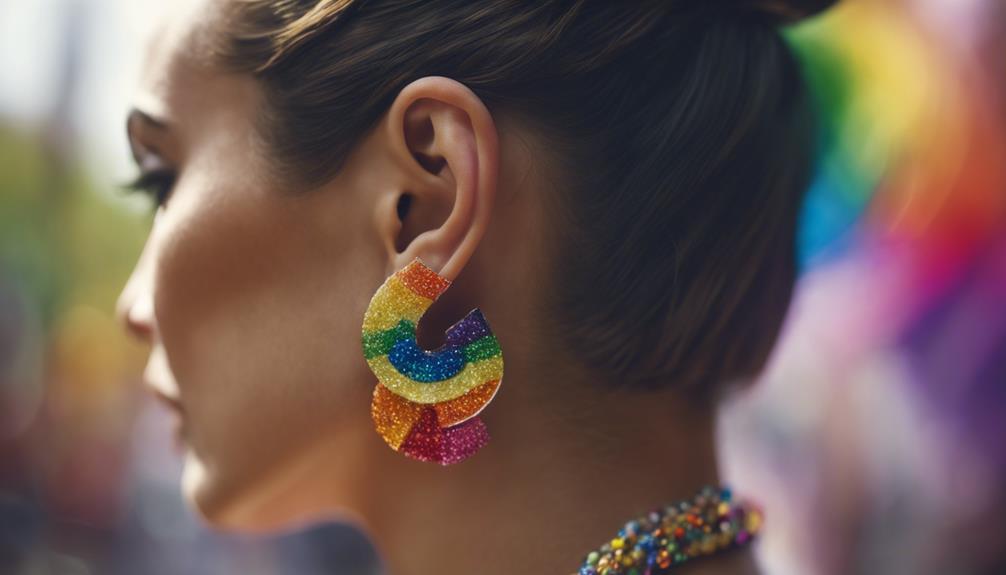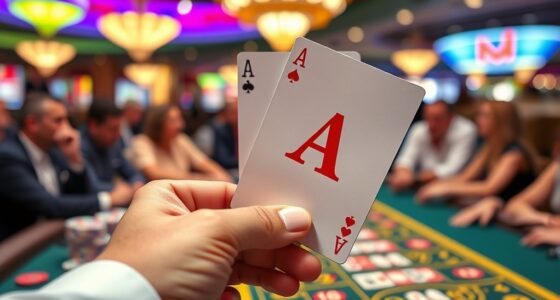The idea that the left ear signifies one's sexual orientation, especially being gay, has roots in secretive communication practices of the 1970s and 1980s. Phrases such as 'Left is right and right is wrong' were used for coded messaging. Initially, the left ear was associated with being gay, functioning as a subtle sign. However, societal changes and evolving attitudes led to a shift towards accepting diversity. Over time, the concept of which ear denotes sexual preference evolved. By exploring this further, one may gain a deeper understanding of the historical context and societal perceptions surrounding the 'gay ear.'
Key Takeaways
- Historical origins link left ear to signify being gay discreetly.
- Left ear piercing historically used for subtle signaling of sexual orientation.
- Evolution of societal attitudes shifted towards greater LGBTQIA+ acceptance.
- Media influence in the 1990s shaped perception of left ear as the 'gay ear'.
- Today, ear piercings symbolize personal style, rebellion, and LGBTQIA+ pride.
Historical Origins of Gay Ear Myth
The historical origins of the gay ear myth can be traced back to the discreet signaling practices of the LGBTQIA+ community in the 1970s and 1980s. Ear piercings were utilized as secret codes for protection and recognition among LGBTQ individuals, creating a subtle yet meaningful way to communicate identity.
The phrase 'Left is right and right is wrong' became associated with the myth of the gay ear, perpetuating stereotypes and misconceptions about which ear signified one's sexual orientation. However, over time, the meaning of which ear symbolized being gay or straight has evolved and varied across different regions, illustrating the complexity and fluidity of such symbols.
As societal attitudes have shifted towards greater acceptance and celebration of diversity, the significance of the gay ear myth has declined. Today, individuals embrace diverse piercing styles as a form of individual expression, breaking away from outdated notions of rigid symbolism and allowing for personal creativity to shine through.
Left Ear Symbolism Explained

Exploring the significance of the left ear in LGBTQIA+ culture reveals a rich history of subtle signaling and identity expression. Historically, the left ear has been symbolically linked to being gay, with roots tracing back to the 1970s and 1980s. This association was reinforced through the discreet code phrase 'left is right, right is wrong' within the LGBTQIA+ community.
Ear piercings on the left ear served as a form of subtle signaling for one's sexual orientation and connection to the gay community. The symbolism of the left ear as the 'gay ear' provided individuals with a means to communicate their identity, especially in times when societal norms may have limited visibility for LGBTQIA+ individuals.
Over time, this symbolism has evolved alongside changing societal attitudes and increased visibility of the LGBTQIA+ community, highlighting the fluidity and adaptability of these forms of expression.
Right Ear Misconceptions Unveiled

Despite the widespread belief in the late 1970s, the right ear being the gay ear is a misconception that gained popularity in the 1990s. Back then, people thought that a left ear piercing signified heterosexuality, while a right ear piercing meant one was gay.
This belief led to individuals using their ear piercings as a way to tell others about their sexual orientation subtly. However, as time passed, the significance of which ear to pierce diminished. Nowadays, the choice of piercing one's left or right ear is more about personal preference and style rather than a coded message.
This evolution in perception highlights a shift towards individual expression rather than conforming to outdated stereotypes. It's essential to debunk these misconceptions to prevent perpetuating stigma and discrimination within the LGBTQ community. Understanding the history behind such beliefs can help foster a more inclusive and accepting society.
Impact of Fashion Trends
Fashion trends have redefined the perception of ear piercings, shifting focus towards personal style and self-expression. In the past, ear piercings, particularly on the left ear, were associated with specific sexual orientations.
However, with the influence of fashion icons challenging stereotypes, the evolution of ear piercings has embraced inclusivity and individuality. Today, individuals view ear piercings as a form of artistic expression rather than a signal of sexual orientation.
The concept of the 'gay ear' has become outdated, with both left and right ear piercings being equally popular choices for individuals seeking to showcase their unique style.
Fashion plays an important role in empowering individuals to break free from old stereotypes and embrace confidence through their fashion choices. By promoting diverse styles and encouraging self-expression, fashion trends have played a significant role in reshaping the narrative around ear piercings, emphasizing personal style over outdated assumptions.
Media Influence on Gay Ear Perception
Media influence in the 1990s greatly shaped the perception that the left ear is considered the 'gay ear'. Stereotypes and sayings such as 'left is right, right is wrong' were spread through various media outlets, solidifying this belief.
The New York Times even contributed to this narrative by publishing an article discussing the gay ear code, further cementing the association between the left ear and homosexuality. This portrayal by the media had negative consequences within the LGBTQ community, leading to stigma and increased bullying targeted at individuals based on which ear they chose to wear an earring in.
The media's role in perpetuating the idea of the gay ear as the left one not only reinforced harmful stereotypes but also added to the challenges faced by many individuals within the LGBTQ community. The impact of media influence on gay ear perception highlights the power of mass media in shaping societal norms and attitudes towards marginalized groups.
Personal Stories and Self-Expression

Personal stories of ear piercing often hold deep significance, serving as visual markers of one's journey towards self-discovery and expression.
Each earring choice can symbolize a unique chapter in an individual's life, reflecting personal growth and embracing one's identity.
Through these narratives, people can challenge stereotypes, celebrate authenticity, and showcase their individuality beyond societal expectations.
Unique Self-Expression Stories
In their journey of self-discovery and identity, individuals have found earrings to be powerful tools for personal expression and challenging stereotypes. The choice to pierce the left ear, historically seen as a bold declaration of identity, holds a transformative power in personal stories.
Earrings symbolize more than just a fashion choice; they embody the essence of self-discovery, allowing individuals to break free from societal norms and embrace their individuality. Each earring worn becomes a statement of personal authenticity, sparking conversations that shape unique narratives and showcase the wearer's bold style choices.
Through the lens of fashion, men have found a platform to challenge stereotypes, boost confidence, and express their individuality in ways that transcend societal expectations. Earrings serve as a tangible representation of personal growth and self-expression, offering a visual language that communicates stories of identity and resilience.
Impact of Personal Narratives
Earrings, as symbols of personal identity and self-expression, hold the power to shape unique narratives and challenge societal norms. Each ear piercing can carry personal stories, reflecting different chapters in one's journey of self-expression. The choice of earrings goes beyond mere fashion; it symbolizes individuality, sparking conversations and interactions that explore one's identity.
Historically, piercing the left ear was a bold declaration of identity, challenging stereotypes and societal expectations. By embracing unique fashion choices like earrings, individuals express their authenticity and uniqueness, breaking free from conventional norms. These personal narratives woven through ear piercings serve as a confirmation of one's journey of self-discovery and self-expression.
Through these accessories, individuals showcase not just their fashion sense but also their inner selves, inviting others to appreciate the depth and richness of their identity beyond superficial appearances.
Dispelling Myths and Stereotypes

The myth of the 'gay ear' has been a longstanding topic of discussion within the LGBTQIA+ community, with various misconceptions surrounding which ear piercing may indicate one's sexual orientation.
By debunking these popular misconceptions and challenging harmful stereotypes, individuals can promote a greater understanding and acceptance of diverse forms of self-expression.
It's essential to navigate these conversations with sensitivity and accuracy to make certain that individuals aren't unfairly judged or stereotyped based on outdated beliefs.
Debunking Popular Misconceptions
Dispelling the myth of the 'gay ear' requires understanding its historical context and evolution within the LGBTQIA+ community. Originating in the 1970s and 1980s, this myth was a discreet signaling method among LGBTQ individuals, as highlighted in a New York Times article. Phrases like 'Left is right and right is wrong' were used, reflecting the need for subtle communication in a time of limited acceptance.
Over time, interpretations of which ear was considered the 'gay ear' varied across the U.S., leading to misconceptions and reversals of meanings in different regions. However, as societal attitudes progressed towards acceptance and self-expression, the significance of this myth diminished. Ear piercings are now viewed more as symbols of rebellion and individuality, symbolizing the positive strides made in gay rights and visibility.
It's essential to debunk this stereotype and recognize the changing landscape of LGBTQ representation and expression.
Challenging Harmful Stereotypes
Challenging harmful stereotypes surrounding the 'gay ear' myth involves understanding its historical roots and dispelling misconceptions within the LGBTQIA+ community.
The myth of the left ear being the 'gay ear' stemmed from the 1970s and 80s as a discreet way for individuals to signal their sexual orientation within the community. This stereotype perpetuated stigma and shame, leading to misconceptions about ear piercings. However, as society progresses, the myth has started to fade, emphasizing acceptance and individual expression.
During Pride Month, it's important to celebrate personal beauty and diversity through self-expression, encouraging everyone to embrace their unique style without judgment.
To challenge harmful stereotypes effectively, it's vital to promote acceptance and understanding within the LGBTQIA+ community and beyond.
Promoting Understanding and Acceptance
Promoting understanding and acceptance involves debunking misconceptions and stereotypes surrounding the outdated notion of the 'gay ear'.
The myth of the 'gay ear' has its roots in the 1970s and 80s when the LGBTQIA+ community adopted discreet signaling through ear piercings for safety. The idea that 'Left is right, and right is wrong' perpetuated this myth, leading to varying interpretations globally.
However, in changing times and modern progress, the significance of the 'gay ear' myth has diminished. Men now embrace diverse piercing styles and placements, emphasizing individual choice and self-expression over hiding behind antiquated codes.
Popular Gay, a New York Times article, highlighted how body piercings are now symbols of personal beauty and LGBTQIA+ pride, rather than markers of sexual orientation.
Frequently Asked Questions
What Does a Man Wearing Earring in Left Ear Mean?
Wearing an earring in the left ear on a man historically signified being gay. Over time, societal attitudes have changed, reducing the significance of this association, allowing for more freedom of self-expression regardless of which ear is adorned.
Why Do Guys Wear Earrings in Their Right Ear?
Curiosity piqued, he explores the reason behind men wearing earrings in their right ear. Today, such adornments are often chosen for personal style rather than signaling sexuality, reflecting evolving norms and individual expression.
Which Ear Should a Boy Get Pierced?
When deciding which ear to pierce, boys should choose based on personal preference and style, as the historical significance of the 'gay ear' has faded. Expressing oneself through an ear piercing is now about individuality and self-expression.
What Earring Side Is Straight?
For those wondering about the straight side for an earring, tradition doesn't dictate a specific ear. Individual preference guides the choice of earring placement. Personal style and comfort play a key role in deciding which ear to pierce.
Conclusion
To sum up, the myth of the 'gay ear' being the left ear has deep historical roots and has been perpetuated by societal norms and media influence.
However, personal stories and self-expression show that ear piercings don't determine one's sexual orientation.
It's important to dispel myths and stereotypes surrounding this issue and recognize that individual style choices shouldn't be used to make assumptions about someone's identity.
Let's embrace diversity and celebrate individuality without judgement.








